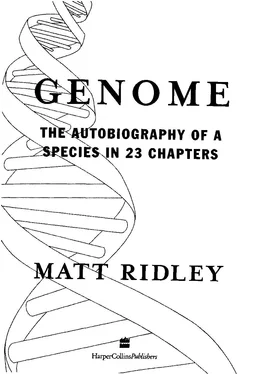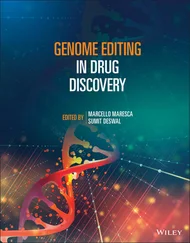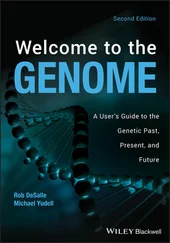Genome - Matt Ridley
Здесь есть возможность читать онлайн «Genome - Matt Ridley» — ознакомительный отрывок электронной книги совершенно бесплатно, а после прочтения отрывка купить полную версию. В некоторых случаях можно слушать аудио, скачать через торрент в формате fb2 и присутствует краткое содержание. Жанр: Старинная литература, на английском языке. Описание произведения, (предисловие) а так же отзывы посетителей доступны на портале библиотеки ЛибКат.
- Название:Matt Ridley
- Автор:
- Жанр:
- Год:неизвестен
- ISBN:нет данных
- Рейтинг книги:5 / 5. Голосов: 1
-
Избранное:Добавить в избранное
- Отзывы:
-
Ваша оценка:
- 100
- 1
- 2
- 3
- 4
- 5
Matt Ridley: краткое содержание, описание и аннотация
Предлагаем к чтению аннотацию, описание, краткое содержание или предисловие (зависит от того, что написал сам автор книги «Matt Ridley»). Если вы не нашли необходимую информацию о книге — напишите в комментариях, мы постараемся отыскать её.
Matt Ridley — читать онлайн ознакомительный отрывок
Ниже представлен текст книги, разбитый по страницам. Система сохранения места последней прочитанной страницы, позволяет с удобством читать онлайн бесплатно книгу «Matt Ridley», без необходимости каждый раз заново искать на чём Вы остановились. Поставьте закладку, и сможете в любой момент перейти на страницу, на которой закончили чтение.
Интервал:
Закладка:
by suggesting that there need be no stability, and that parasites could cause a perpetual cycling fluctuation in gene frequencies. By the 1980s the torch had passed to the Australian Robert May, who demonstrated that even in the simplest system of a parasite and its host, there might be no equilibrium outcome: that eternal chaotic motion could flow from a deterministic system. May thus became one of the fathers of chaos theory. The baton was picked up by the Briton William Hamilton, who developed mathematical models to explain the evolution of sexual reproduction, models that relied upon a genetic arms race between parasites and their hosts, and which resulted in what Hamilton called 'the permanent unrest of many [genes]'.10
Some time in the 1970s, as happened in physics half a century before, the old world of certainty, stability and determinism in biology fell. In its place we must build a world of fluctuation, change and unpredictability. The genome that we decipher in this generation is but a snapshot of an ever-changing document. There is no definitive edition.
C H R O M O S O M E 1 0
S t r e s s
This is the excellent foppery of the world, that, when we are sick in fortune — often the surfeit of our own behaviour, — we make guilty of our disasters the sun, the moon, and the stars; as if we were villains by necess-ity, fools by heavenly compulsion . . . an admirable eva-sion of whoremaster man, to lay his goatish disposition to the charge of a star. William Shakespeare, King Lear The genome is a scripture in which is written the past history of plagues. The long struggles of our ancestors with malaria and dysentery are recorded in the patterns of human genetic variation. Your chances of avoiding death from malaria are pre-programmed in your genes, and in the genes of the malaria organism. You send out your team of genes to play the match, and so does the malaria parasite.
If their attackers are better than your defenders, they win. Bad luck.
No substitutes allowed.
But it is not like that, is it? Genetic resistance to disease is the last resort. There are all sorts of simpler ways of defeating disease.
Sleep under a mosquito net, drain the swamps, take a pill, spray 1 4 8 G E N O M E
D D T around the village. Eat well, sleep well, avoid stress, keep your immune system in good health and generally maintain a sunny disposition. All of these things are relevant to whether you catch an infection. The genome is not the only battlefield. In the last few chapters I have fallen into the habit of reductionism. I have taken the organism apart to isolate its genes and discern their particular interests. But no gene is an island. Each one exists as part of an enormous confederation called the body. It is time to put the organism back together again. It is time to visit a much more social gene, a gene whose whole function is to integrate some of the many different functions of the body, and a gene whose existence gives the lie to the mind-body dualism that plagues our mental image of the human person. The brain, the body and the genome are locked, all three, in a dance. The genome is as much under the control of the other two as they are controlled by it. That is partly why genetic determinism is such a myth. The switching on and off of human genes can be influenced by conscious or unconscious external action.
Cholesterol — a word pregnant with danger. The cause of heart disease; bad stuff; red meat. You eat it, you die. Nothing could be more wrong than this equation of cholesterol with poison. Cholesterol is an essential ingredient of the body. It lies at the centre of an intricate system of biochemistry and genetics that integrates the whole body. Cholesterol is a small organic compound that is soluble in fat but not in water. The body manufactures most of its cholesterol from sugars in the diet, and could not survive without it. From cholesterol at least five crucial hormones are made, each with a very different task: progesterone, aldosterone, Cortisol, testosterone and oestradiol. Collectively, they are known as the steroids. The relationship between these hormones and the genes of the body is intimate, fascinating and unsettling.
Steroids have been used by living creatures for so long that they probably pre-date the split between plants, animals and fungi. The hormone that triggers the shedding of an insect's skin is a steroid.
So is the enigmatic chemical known in human medicine as vitamin D. Some synthetic, or anabolic, steroids can be manufactured to S T R E S S 149
trick the body into suppressing inflammation, while others can be used for building athletes' muscles. Yet other steroids, derived originally from plants, can mimic human hormones sufficiently well to be used as oral contraceptives. Others still, products of the chemical industry, may be responsible for the ferninisation of male fish in polluted streams and the falling sperm counts of modern men.
There is a gene on chromosome 10 called CYP17. It makes an enzyme, which enables the body to convert cholesterol into Cortisol, testosterone and oestradiol. Without the enzyme, the pathway is blocked and the only hormones that can be made from cholesterol are progesterone and corticosterone. People who lack a working copy of this gene cannot make other sex hormones so they fail to go through puberty; if genetically male, they look like girls.
But put the sex hormones on one side for a moment and consider the other hormone that is made using CYP17. Cortisol. Cortisol is used in virtually every system in the body, a hormone that literally integrates the body and the mind by altering the configuration of the brain. Cortisol interferes with the immune system, changes the sensitivity of the ears, nose and eyes, and alters various bodily functions. When you have a lot of Cortisol coursing through your veins, you are - by definition — under stress. Cortisol and stress are virtually synonymous.
Stress is caused by the outside world, by an impending exam, a recent bereavement, something frightening in the newspaper or the unremitting exhaustion of caring for a person with Alzheimer's disease. Short-term stressors cause an immediate increase in epinephrine and norepinephrine, the hormones that make the heart beat faster, the feet go cold. These hormones prepare the body for 'fight or flight' in an emergency. Stressors that last for longer activate a different pathway that results in a much slower, but more persistent increase in Cortisol. One of Cortisol's most surprising effects is that it suppresses the working of the immune system. It is a remarkable fact that people who have been preparing for an important exam, and have shown the symptoms of stress, are more likely to catch colds and other infections, because one of the effects of Cortisol is to reduce the 1 5 0 G E N O M E
activity, number and lifetime of lymphocytes — white blood cells.
Cortisol does this by switching genes on. It only switches on genes in cells that have Cortisol receptors in them, which have in turn been switched on by some other triggers. The genes that it switches on mostly switch on other genes in turn, and sometimes the genes that they switch on will then switch on other genes and so on. The secondary effects of Cortisol can involve tens, or maybe even hundreds, of genes. But the Cortisol was only made in the first place because a series of genes was switched on in the adrenal cortex to make the enzymes necessary for making Cortisol - among them CYP17. It is a system of mindboggling complexity: if I started to list even the barest outlines of the actual pathways I would bore you to tears. Suffice to say that you cannot produce, regulate and respond to Cortisol without hundreds of genes, nearly all of which work by switching each other on and off. It is a timely lesson that the main purpose of most genes in the human genome is regulating the expression of other genes in the genome.
Читать дальшеИнтервал:
Закладка:
Похожие книги на «Matt Ridley»
Представляем Вашему вниманию похожие книги на «Matt Ridley» списком для выбора. Мы отобрали схожую по названию и смыслу литературу в надежде предоставить читателям больше вариантов отыскать новые, интересные, ещё непрочитанные произведения.
Обсуждение, отзывы о книге «Matt Ridley» и просто собственные мнения читателей. Оставьте ваши комментарии, напишите, что Вы думаете о произведении, его смысле или главных героях. Укажите что конкретно понравилось, а что нет, и почему Вы так считаете.












